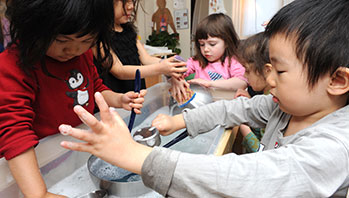- cardboard
- construction paper
- paper and markers
- plastic pipettes or eyedroppers
- small containers of water
- toothpicks
- wax paper
- drop
MA Standards:
Language/L.PK.MA.6: Use words and phrases acquired through conversations, listening to books read aloud, activities, and play.
MA Draft STE Standards:
Earth and Space Sciences/Earth’s Systems/ESS2.A: Observe, investigate, and classify the non-living materials, natural and human made, in their environment.
Head Start Outcomes:
Logic and Reasoning/Reasoning and Problem Solving: Classifies, compares, and contrasts objects, events, and experiences.
Science Knowledge/Scientific Skills and Method: Collects, describes, and records information through discussions, drawings, maps, and charts.
Science Knowledge/Conceptual Knowledge of Natural and Physical Worlds: Observes, describes, and discusses properties of materials and transformation of substances.
PreK Learning Guidelines:
English Language Arts/Language 2: Participate actively in discussions, listen to the ideas of others, and ask and answer relevant questions.
Science and Technology/Inquiry Skills 4: Record observations and share ideas through simple forms of representation such as drawings.
Science and Technology/Physical Sciences 19: Explore, describe, and compare the properties of liquids and solids found in children's daily environment.
Explore Together (indoors): Drop Size and Shape

© Commonwealth of Massachusetts, Department of Early Education and Care (Jennifer Waddell photographer). All rights reserved.
STEM Key Concepts: Water can flow quickly or slowly; Water in small amounts forms drops; Water drops stick together; Water behaves differently on different surfaces
ELA Focus Skills: Listening and Speaking, Vocabulary
Tell children they will continue to explore water drops by observing how water drops behave on different surfaces.
Introduce the materials to children. Show them how to squirt water onto the wax paper. Then encourage them to explore making drops and working with drops on the paper. For example, have them use a toothpick to push the water drops around the wax paper. Talk with children about what they notice.
- What do the water drops look like––think about size and shape?
- How are big drops and small drops the same and different?
- I wonder what will happen if you hit the big drops with your toothpick.
- Look! Nia pushed two little drops really close together. Tell us what happened, Nia. Let’s see if your drops can do that, too.
- Take your favorite drop for a walk around the wax paper. Tell me a story about what happens.
After children have had time to explore, encourage them to draw a picture showing what happens to the water drops. Encourage them to draw as much detail as possible, including the different sizes and shapes of drops. Challenge them to draw a picture showing a drop that is moving.
Reflect and Share
Bring children together. Invite children to share their drawings and their discoveries with the group. Ask, What did you notice about different sizes and shapes of drops? How were big and small drops the same and different? How do you know water sticks together? What did you see today that helps you to know?
Adaptation: You might prefer to have very young children do the activity individually, with one-to-one supervision.
